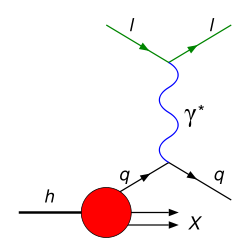- Deep inelastic scattering
-
Deep inelastic scattering is the name given to a process used to probe the insides of hadrons (particularly the baryons, such as protons and neutrons), using electrons, muons and neutrinos. It provided the first convincing evidence of the reality of quarks, which up until that point had been considered by many to be a purely mathematical phenomenon. It is a relatively new process, first attempted in the 1960s and 1970s. It is an extension of Rutherford scattering to much higher energies of the scattering particle and thus to much smaller resolution of the components of the nuclei. [1]
Quarks
The Standard Model of physics, particularly given the work of Murray Gell-Mann in the 1960s, had been successful in uniting much of the previously disparate concepts in particle physics into one, relatively straightforward, scheme. In essence, there were three types of particles.
- The leptons, which were light (as in not particularly massive) particles such as electrons, neutrinos and their antiparticles. They have integer charge
- The bosons, which were particles that exchange forces. These ranged from the massless, easy-to-detect photon (the carrier of the electro-magnetic force) to the exotic (though still massless) gluons that carry the strong nuclear force
- The quarks, which were massive particles that carried fractional charges. They are the "building blocks" of the hadrons. They are also the only particles to be affected by the strong interaction
The leptons had been detected since 1897, when J. J. Thomson had shown that electric current is a flow of electrons. Some bosons were being routinely detected, although the W+, W- and Z0 particles of the electroweak force were only categorically seen in the early 1980s, and gluons were only firmly pinned down at DESY in Hamburg at about the same time. Quarks, however, were still elusive.
References
- ^ Deep inelastic scattering. Oxford University Physics Department, 2003.
Categories:- Scattering
- Experimental particle physics
- Particle physics stubs
Wikimedia Foundation. 2010.

